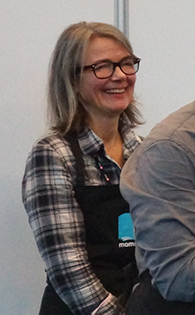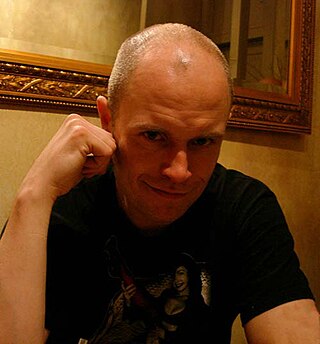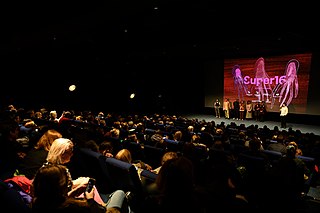CPH, CpH, Cph, or cph may refer to:
Copenhagen International Film Festival (CIFF) was a film festival held annually in Copenhagen, Denmark, from 2003 to 2008. The main prize, the Golden Swan, was awarded for Best Film, Best Director, Best Actress, Best Actor, Best Script and Best Cinematography. In 2009, CIFF merged with the NatFilm Festival to become the CPH PIX film festival.

The National Film School of Denmark is an independent institution under the Danish Ministry of Cultural Affairs. It was established in 1966 and is based on Holmen in the harbour of Copenhagen.
The NatFilm Festival, staged annually across 16 cinemas in Copenhagen, in addition to several in Odense, Aalborg and Århus, shows the widest programme of films to the largest festival audience in Denmark. Established in 1990, it rivals the more recently established Copenhagen International Film Festival which emerged in 2003 in prestige though not directly - NatFilm generally occurs in Easter, around the beginning of April, whereas the CIFF is staged in September. Since 2003 NatFilm has steadily attracted a total audience of around 35,000 over its annual ten-day run.
CPH:DOX, also known as Copenhagen International Documentary Film Festival, is a Danish film festival focused on documentary films, held annually in Copenhagen, Denmark. Since 2008 it has been run by Copenhagen Film Festivals, which also managed the now-defunct CPH PIX festival.

The Swedish Film Institute (SFI) is a statutory body located in Stockholm, Sweden that supports the Swedish film industry. Founded in 1963, the institute is responsible for administering the annual Guldbagge Awards, and for managing the Swedish Film Database. Notable CEOs of the institute include founder-director Harry Schein and Anna Serner (2011–2021). Serner is known for creating an initiative which aimed for gender parity in the film industry. Since mid-April 2024 the CEO is Anna Croneman.
The Danish Institute for Human Rights (DIHR), formerly the Danish Centre for Human Rights, is a national human rights institution (NHRI) operating in accordance with the UN Paris Principles.

The 2008 NatFilm Festival ran from March 28, 2008 to April 6, 2008. NatFilm Festival is now merged with CIFF into one single event, CPH PIX, launched on April 16–26, 2009.

Vibeke Hastrup is a Danish actress who works in theatre, television and film. She performed in the films Babette's Feast and Dance of the Polar Bears, and has done numerous voice-overs for animated features such as Tarzan, Robots and Wallace & Gromit: The Curse of the Were-Rabbit.
Alice O'Fredericks was a Danish actress, screenwriter, and film director. She is best known for directing the series of Far til Fire comedies and the series of family dramas based on Morten Korch novels. Having written 38 produced screenplays and directed 72 feature films, O'Fredericks was one of the most prolific directors in Danish cinema. O'Fredericks also directed the first Danish films which highlighted women's rights. The Alice Award, presented annually to the Best Female Director at the Copenhagen International Film Festival, is named in her honor.

Tao Nørager is a Danish Film director specializing in documentaries.
CPH PIX was a film festival that takes place annually in Copenhagen, Denmark. Created when the Copenhagen International Film Festival and the NatFilm Festival were merged in 2008, the festival ran from 2009 until 2021. It was run by Copenhagen Film Festivals, which also manages the documentary festival CPH:DOX. CPH PIX incorporated Buster Film Festival for Children and Youth between 2016 and 2018.

Gothersgade is a major street in the City Centre of Copenhagen, Denmark. It extends from Kongens Nytorv to Sortedam Lake, passing Rosenborg Castle and Gardens, Nørreport Station and Copenhagen Botanic Gardens on the way.
The Danish Film Academy is a Danish organisation the promotes the film industry.

Super16 is a Danish non-traditional film school based at the Nordisk Film Studio in Valby, Copenhagen. The name of the school refers to both the economical Super 16 mm film gauge, and to the number of participants in each class: 6 directors, 6 producers and 4 screenwriters. Each class program is for a 3-year period and produces 6 films annually. Although English-speaking applicants can apply, all instruction and communication is held in Danish.
Fenar Ahmad is a Danish filmmaker of Iraqi origin. He was born in 1981 in Czechoslovakia to immigrant Iraqi parents. In 1986 the family emigrated to Denmark. There he studied film in the alternative film school Super16.

Michael Noer is a Danish film director.

Ellen Aggerholm née Abrahams (1882–1963) was a Danish stage and screen actress. She made her debut in Attester at Copenhagen's Folketeatret in 1901. In 1911, she moved to London where she first played Puck in Shakespeare's A Midsummer Night's Dream at Her Majesty's Theatre. She returned to Denmark when war broke out in 1914, touring with her husband's company until 1917. She then joined the Odense Theatre where she became the principal actress until 1924. She went on to tour the provinces until she performed in repertoire at the Casino Theatre in Copenhagen. After a long career, she retired from the stage in 1947. While young, Aggerholm performed a number of leading roles in mainly short silent films released by Nordisk Film from 1910 to 1915.
Twice Colonized is a documentary film, directed by Lin Alluna and released in 2023. The film is a co-production of companies from Canada, Denmark and Greenland, and profiles Aaju Peter, an Inuk lawyer and activist who has lived in both Greenland and Nunavut, documenting both her activism for Inuit rights and her personal struggles.










